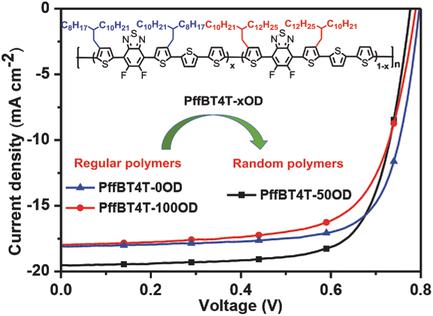当前位置:
X-MOL 学术
›
Adv. Energy Mater.
›
论文详情
Our official English website, www.x-mol.net, welcomes your
feedback! (Note: you will need to create a separate account there.)
A Facile Method to Fine‐Tune Polymer Aggregation Properties and Blend Morphology of Polymer Solar Cells Using Donor Polymers with Randomly Distributed Alkyl Chains
Advanced Energy Materials ( IF 24.4 ) Pub Date : 2017-10-10 , DOI: 10.1002/aenm.201701895 Huatong Yao 1 , Yunke Li 1 , Huawei Hu 1 , Philip C. Y. Chow 1 , Shangshang Chen 1 , Jingbo Zhao 1 , Zhengke Li 1 , Joshua H. Carpenter 2 , Joshua Yuk Lin Lai 1 , Guofang Yang 1 , Yuhang Liu 1 , Haoran Lin 1 , Harald Ade 2 , He Yan 1, 3
Advanced Energy Materials ( IF 24.4 ) Pub Date : 2017-10-10 , DOI: 10.1002/aenm.201701895 Huatong Yao 1 , Yunke Li 1 , Huawei Hu 1 , Philip C. Y. Chow 1 , Shangshang Chen 1 , Jingbo Zhao 1 , Zhengke Li 1 , Joshua H. Carpenter 2 , Joshua Yuk Lin Lai 1 , Guofang Yang 1 , Yuhang Liu 1 , Haoran Lin 1 , Harald Ade 2 , He Yan 1, 3
Affiliation

|
The device performance of polymer solar cells (PSCs) is strongly dependent on the blend morphology. One of the strategies for improving PSC performance is side‐chain engineering, which plays an important role in controlling the aggregation properties of the polymers and thus the domain crystallinity/purity of the donor–acceptor blends. In particular, for a family of high‐performance donor polymers with strong temperature‐dependent aggregation properties, the device performances are very sensitive to the size of alkyl chains, and the best device performance can only be achieved with an optimized odd‐numbered alkyl chain. However, the synthetic route of odd‐numbered alkyl chains is costly and complicated, which makes it difficult for large‐scale synthesis. Here, this study presents a facile method to optimize the aggregation properties and blend morphology by employing donor polymers with a mixture of two even‐numbered, randomly distributed alkyl chains. In a model polymer system, this study suggests that the structural and electronic properties of the random polymers comprising a mixture of 2‐octyldodecyl and 2‐decyltetradecyl alkyl chains can be systematically tuned by varying the mixing ratio, and a high power conversion efficiency (11.1%) can be achieved. This approach promotes the scalability of donor polymers and thus facilitates the commercialization of PSCs.
中文翻译:

使用具有随机分布烷基链的供体聚合物微调聚合物聚集特性和聚合物太阳能电池混合形态的简便方法
聚合物太阳能电池(PSC)的器件性能在很大程度上取决于共混物的形态。改善PSC性能的策略之一是侧链工程,它在控制聚合物的聚集特性以及供体-受体共混物的畴结晶度/纯度方面起着重要作用。特别是,对于具有强的温度依赖性聚集特性的高性能供体聚合物,该器件的性能对烷基链的大小非常敏感,并且只有通过优化的奇数烷基链才能获得最佳的器件性能。 。但是,奇数烷基链的合成路线既昂贵又复杂,这使其难以大规模合成。这里,这项研究提出了一种简便的方法,通过使用供体聚合物与两个偶数,随机分布的烷基链的混合物来优化聚集特性和共混物形态。在模型聚合物系统中,这项研究表明,可以通过改变混合比例和高功率转换效率来系统地调节包含2-辛基十二烷基和2-癸基十四烷基烷基链的混合物的无规聚合物的结构和电子性质。 %) 可以实现。这种方法促进了供体聚合物的可扩展性,从而促进了PSC的商业化。这项研究表明,可以通过改变混合比来系统地调节包含2-辛基十二烷基和2-癸基十四烷基烷基链的混合物的无规聚合物的结构和电子性能,并可以实现高功率转换效率(11.1%)。这种方法促进了供体聚合物的可扩展性,从而促进了PSC的商业化。这项研究表明,可以通过改变混合比来系统地调节包含2-辛基十二烷基和2-癸基十四烷基烷基链的无规聚合物的结构和电子性质,并可以实现高功率转换效率(11.1%)。这种方法促进了供体聚合物的可扩展性,从而促进了PSC的商业化。
更新日期:2017-10-10
中文翻译:

使用具有随机分布烷基链的供体聚合物微调聚合物聚集特性和聚合物太阳能电池混合形态的简便方法
聚合物太阳能电池(PSC)的器件性能在很大程度上取决于共混物的形态。改善PSC性能的策略之一是侧链工程,它在控制聚合物的聚集特性以及供体-受体共混物的畴结晶度/纯度方面起着重要作用。特别是,对于具有强的温度依赖性聚集特性的高性能供体聚合物,该器件的性能对烷基链的大小非常敏感,并且只有通过优化的奇数烷基链才能获得最佳的器件性能。 。但是,奇数烷基链的合成路线既昂贵又复杂,这使其难以大规模合成。这里,这项研究提出了一种简便的方法,通过使用供体聚合物与两个偶数,随机分布的烷基链的混合物来优化聚集特性和共混物形态。在模型聚合物系统中,这项研究表明,可以通过改变混合比例和高功率转换效率来系统地调节包含2-辛基十二烷基和2-癸基十四烷基烷基链的混合物的无规聚合物的结构和电子性质。 %) 可以实现。这种方法促进了供体聚合物的可扩展性,从而促进了PSC的商业化。这项研究表明,可以通过改变混合比来系统地调节包含2-辛基十二烷基和2-癸基十四烷基烷基链的混合物的无规聚合物的结构和电子性能,并可以实现高功率转换效率(11.1%)。这种方法促进了供体聚合物的可扩展性,从而促进了PSC的商业化。这项研究表明,可以通过改变混合比来系统地调节包含2-辛基十二烷基和2-癸基十四烷基烷基链的无规聚合物的结构和电子性质,并可以实现高功率转换效率(11.1%)。这种方法促进了供体聚合物的可扩展性,从而促进了PSC的商业化。











































 京公网安备 11010802027423号
京公网安备 11010802027423号